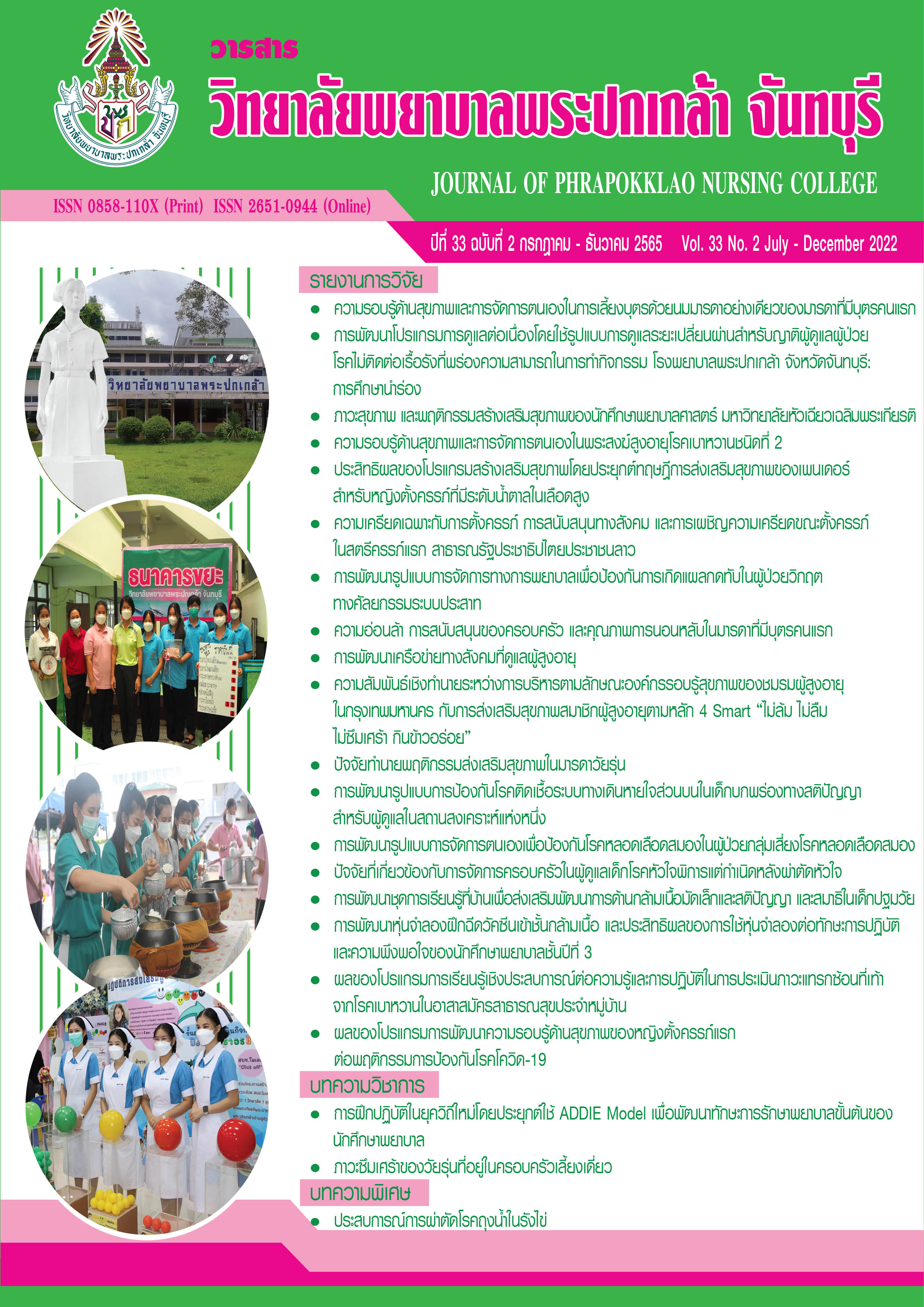The Development of a Self-management Model for Stroke Prevention in Stroke Risk Group Patients
Keywords:
Self-management model, Stroke prevention, Stroke risk group patientsAbstract
This research and development aimed to develop and study the effect of a self-management model for stroke prevention in stroke risk group patients. There were five phases of research including: 1) exploring problems and needs of patients; 2) developing a self-management model for stroke prevention in stroke risk group patients; 3) trying out a self-management model with 10 stroke risk group patients; 4) improving a self-management model; and 5) evaluating a self-management model with 50 stroke risk group patients who received the medical services at Nong Bua Health Promoting Hospital, Mueang Chanthaburi District, Chanthaburi Province. The research instruments consisted of a semi-structured interview form, a self-management model for stroke prevention in stroke risk group patients, a handbook of self-management for stroke prevention, a demographic record form, a self-management behavior for stroke prevention questionnaire with reliability of .80, and a risk of stroke assessment form. The implementation and data collection were conducted from August, 2020 to July, 2021. Data were analyzed using frequency, percentage, paired t-test, and summation method.
The research results revealed that 1) the self-management model for stroke prevention in stroke risk group patients consisted of these main activities: providing knowledge, giving a handbook of self-management, recording health data, selecting goal, evaluating health status, and making decision for behavior modification; 2) after implementing the self-management model, stroke risk group patients had statistically significantly higher mean score of self-management behavior for stroke prevention than that of before implementing the self-management model (t = 3.592, p < .01); and 3) after implementing the self-management model, stroke risk group patients had statistically significantly lower mean score of risk of stroke than that of before implementing the self-management model (t = 2.072, p < .05).
This research suggests that community nurses should apply this self-management model for stroke prevention in stroke risk group patients to promote self-management. This will help stroke risk group patients modify their health behaviors and prevent the occurrence of stroke.
References
กฤติจิรา เตชะรุจิรา, วีนัส ลีฬหกุล, และศากุล ช่างไม้. (2562). ผลของโปรแกรมการปรับเปลี่ยนพฤติกรรมเพื่อลดความเสี่ยงการเกิดโรคหัวใจและหลอดเลือดของบุคลากรที่มีภาวะเมตาบอลิกซินโดรมในโรงพยาบาลเอกชน. วารสารโรงพยาบาลเจริญกรุงประชารักษ์, 15(2), 14–33.
คณิตตา อินทบุตร. (2563). ผลของโปรแกรมการจัดการตนเองร่วมกับแรงสนับสนุนทางสังคมในผู้ป่วยความดันโลหิตสูงรายใหม่ ที่ควบคุมระดับความดันโลหิตไม่ได้. วารสารวิชาการสำนักงานป้องกันควบคุมโรคที่ 9 จังหวัดนครราชสีมา, 26(1), 73–83.
ชดช้อย วัฒนะ. (2558). การสนับสนุนการจัดการตนเอง: กลยุทธ์ในการส่งเสริมการควบคุมโรค. วารสารวิทยาลัยพยาบาลพระปกเกล้า จันทบุรี, 26(เพิ่มเติม 1), 117–127.
ชื่นชม สมพล, ทัศนีย์ รวิวรกุล, และพัชราพร เกิดมงคล. (2560). ผลของโปรแกรมการป้องกันโรคหลอดเลือดสมองสำหรับผู้สูงอายุโรคความดันโลหิตสูง. วารสารพยาบาลสาธารณสุข, 31(พิเศษ), 57–74.
ดาราวรรณ รองเมือง. (2561). การทบทวนทฤษฎีทางพฤติกรรมศาสตร์ในการปรับเปลี่ยนพฤติกรรมสุขภาพเพื่อป้องกันโรคอ้วน. วารสารศูนย์การศึกษาแพทยศาสตร์คลินิก โรงพยาบาลพระปกเกล้า, 35(1), 77–92.
ดารินทร์ อารีย์โชคชัย. (2560). โรคหลอดเลือดสมอง…กับ ปัจจัยเสี่ยงที่หลีกเลี่ยงได้. จับตาโรคและภัยสุขภาพ, 4(5). สืบค้นจาก file:///C:/Users/Admin/Downloads/final_20_04_2560_1494295691.pdf
ประเพ็ญพร ชำนาญพงษ์, และลัฆวี ปิยะบัณฑิตกุล. (2559). การป้องกันโรคหลอดเลือดสมองในผู้ป่วยโรคความดันโลหิตสูงในชุมชนกึ่งเมือง. วารสารการพัฒนาสุขภาพชุมชน มหาวิทยาลัยขอนแก่น, 4(3), 325–340.
ปริญญ์ วาทีสาธกกิจ. (ม.ป.ป.). Thai CV risk score. สืบค้นจาก http://thaincd.com/document/file/download/powerpoint/THAICV~1.PDF
พันทิพพา บุญเศษ, และลัฆวี ปิยะบัณฑิตกุล. (2561). ผลของโปรแกรมการป้องกันโรคหลอดเลือดสมองในกลุ่มเสี่ยงสูง ตำบลห้วยบง อำเภอเมือง จังหวัดชัยภูมิ. วารสารโรงพยาบาลสกลนคร, 21(2), 28–41.
โรงพยาบาลส่งเสริมสุขภาพตำบลหนองบัว อำเภอเมืองจันทบุรี จังหวัดจันทบุรี. (2563). ข้อมูลผู้ป่วยโรคความดันโลหิตสูงและโรคเบาหวาน โรงพยาบาลส่งเสริมสุขภาพตำบลในจังหวัดจันทบุรี ปี พ.ศ. 2563. จันทบุรี: ผู้แต่ง.
ละอองดาว คำชาตา, ชดช้อย วัฒนะ, และธีรนุช ห้านิรัติศัย. (2560). ผลของโปรแกรมการจัดการตนเองต่อพฤติกรรมการจัดการตนเอง เส้นรอบวงเอว ระดับน้ำตาลในเลือด และความเสี่ยงต่อการเกิดโรคหัวใจและหลอดเลือดในผู้ที่มีกลุ่มอาการเมตาโบลิก. พยาบาลสาร, 44(3), 65–76.
สมชัย อัศวสุดสาคร, สุรสิทธิ์ จิตรพิทักษ์เลิศ, และสาวิตรี วิษณุโยธิน. (2562). การบูรณาการระบบบริการสุขภาพเพื่อคัดกรองและลดกลุ่มเสี่ยงสูงต่อการเกิดโรคหัวใจและหลอดเลือด จังหวัดนครราชสีมา 2560–2561. วารสารกรมการแพทย์, 44(5), 150–157.
สำนักโรคไม่ติดต่อ กรมควบคุมโรค. (2560). คู่มือการประเมินโอกาสเสี่ยงต่อการเกิดโรคหัวใจขาดเลือด และโรคหลอดเลือดสมอง (อัมพฤกษ์ อัมพาต) สำหรับอาสาสมัครสาธารณสุขประจำหมู่บ้าน (อสม.). กรุงเทพฯ: สำนักงานกิจการโรงพิมพ์ องค์การสงเคราะห์ทหารผ่านศึก ในพระบรมราชูปถัมภ์.
สำนักโรคไม่ติดต่อ กรมควบคุมโรค. (2561). รายงานประจำปี 2561. กรุงเทพฯ: อักษรกราฟฟิค แอนด์ ดีไซน์.
สุพัตรา สิทธิวัง. (2560). ผลของโปรแกรมส่งเสริมการจัดการตนเองต่อพฤติกรรมสุขภาพและระดับความดันโลหิต ของผู้ที่เป็นโรคความดันโลหิตสูงที่ควบคุมไม่ได้ (วิทยานิพนธ์ปริญญามหาบัณฑิต). มหาวิทยาลัยเชียงใหม่.
อารีย์ เสนีย์. (2557). โปรแกรมการจัดการตนเองในผู้ป่วยโรคเรื้อรัง. วารสารพยาบาลทหารบก, 15(2), 129–134.
Creer, L. T. (2000). Self-management of chronic illness. In M. Boekaerts, P. R. Pintrich, & M. Zeidner (Eds.). Handbook of self-regulation (pp. 601–629). San Diego, CA: Academic Press.
Jiang, W., Zhang, Y., Yan, F., Liu, H., & Gao, R. (2020). Effectiveness of a nurse-led multidisciplinary self-management program for patients with coronary heart disease in communities: A randomized controlled trial. Patient Education and Counseling, 103(4), 854–863. doi:10.1016/j.pec.2019.11.001
Nguyen, N. T., Douglas, C., & Bonner, A. (2019). Effectiveness of self-management programme in people with chronic kidney disease: A pragmatic randomized controlled trial. Journal of Advanced Nursing, 75(3), 652–664. doi:10.1111/jan.13924
Suwanwela, N. C. (2014). Stroke epidemiology in Thailand. Journal of Stroke, 16(1), 1–7. doi:10.5853/jos.2014.16.1.1
World Stroke Organization. (2018). World Stroke Organization (WSO) Annual Report 2018. Geneva: Author. Retrieved from https://www.world-stroke.org/assets/downloads/Annual_Report_2018_online_fnal_COMPRESSED.pdf
Downloads
Published
How to Cite
Issue
Section
License
Copyright (c) 2022 JOURNAL OF PHRAPOKKLAO NURSING COLLEGE

This work is licensed under a Creative Commons Attribution-NonCommercial-NoDerivatives 4.0 International License.
เนื้อความ ข้อมูล และรายการอ้างอิงที่ผู้เขียนใช้ในการเขียนบทความเพื่อลงตีพิมพ์ในวารสารวิทยาลัยพยาบาลพระปกเกล้า จันทบุรี ถือเป็นความคิดเห็นและความรับผิดชอบของผู้เขียน คณะผู้จัดทำวารสารไม่จำเป็นต้องเห็นพ้องด้วยหรือร่วมรับผิดชอบ
บทความที่ได้รับการลงตีพิมพ์ในวารสารวิทยาลัยพยาบาลพระปกเกล้า จันทบุรี ถือเป็นลิขสิทธิ์ของวารสารวิทยาลัยพยาบาลพระปกเกล้า จันทบุรี หากหน่วยงานหรือบุคคลใดต้องการนำส่วนหนึ่งหรือทั้งหมดของบทความไปเผยแพร่ต่อเพื่อวัตถุประสงค์ใด ๆ จะต้องได้รับอนุญาตจากบรรณาธิการวารสารก่อน



